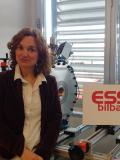Nagore Garmendia

Nagore Garmendia
Nagore Garmendia received her degrees in electronic physics and electronic engineering from the University of Basque Country. After she was working in Tecnalia and Alcatel Espacio, during respectively 1 and 5 years as RF engineer, she returned to University of Basque Country. In the RF group, she participated as researcher for several R&D projects in the telecommunications and RF area, as well as she worked as assistant professor of the electronic engineering degree. During these 4 years, she obtained the Ph.D in noise characterization experimental techniques of microwave devices. At the end of 2008 she started to work at ESS Bilbao Consortium developing diverse task mainly related with the RF System project. Currently she is the RF System Group Head participating and coordinating the development of RF chains for the NC linac and the buncher cavities for the MEBT.
Nagore's daily work includes leading the coordination of the RF system In-Kind Contribution from ESS Bilbao to ESS Lund. The RF team, from the ESS specifications, oversees the entire process up to delivering operating RF chains for each type of NC cavities. The RF team designs, simulates, manufactures, tests, validates and integrates the components of the RF TX subsystems before delivering to ESS Lund. In all these tasks multiple issues can come out during her daily activities, which are reported to the Field Coordinators of the Iberia Hub to reduce the risks. She must work with multiple and diverse interfaces among subsystems, she must communicate and coordinate with numerous and diverse groups and has to manage many information from different departments and moreover the deadlines require very effective implementations.
BrightnESS is a good initiative to support and coordinate all works from all partners. It is a great opportunity to put in common different experiences as well as to be able to learn of the other partners backgrounds. The multidisciplinary members permit to have different points of views, to create new ideas and to able to progress in an innovation knowledge. It is important to make the whole community aware of all the neutron research benefits in their daily lives and in general bring the science progress closer to society.
In BrightnESS Nagore's key challenges are to reduce the risk and improve the coordination of the development of RF systems works and coordinate internally with her colleagues the In-Kind works. The RF sub-systems have multiple interfaces with other systems developed by diverse types of entities. The multiple and diversity interfaces make the management and efficient communication a big challenge. The timeline also is a crucial challenge in the ESS project. Innovative technologies, last generation designs and new developments must be validated independently and to be successfully integrated in the entire system on time. BrightnESS can set the tools to improve the communication among all the ESS project participants and establish an efficient network of innovation culture at different level for partners, organisms, user community and society. ESS project is the most challenging scientific project in which all the involved people, particularly the staff involved in the BrightnESS project, must do their bit in order to achieve a thorough and real success.

 is funded by the European Union Framework Programme for Research and Innovation Horizon 2020, under grant agreement 676548.
is funded by the European Union Framework Programme for Research and Innovation Horizon 2020, under grant agreement 676548.